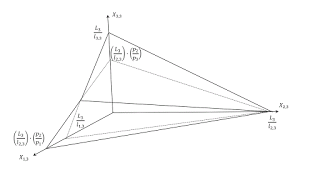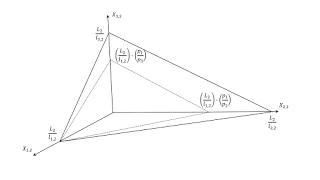Figure 1: The Production Possibility Frontier, With And Without Trade, In "Germany"1.0 Introduction I continue to blunder around in parameter space in exploring my numeric example in the previous post. In this post, I continue to adopt the same assumptions for a model of three countries engaged in international trade with three produced commodities. In particular, workers are assumed to be unable to immigrate, capitalists only invest in their own country, and produced means of production are not traded. Thus, wage rates and rates of profits may vary among countries, with no tendency to change or approach equality. 2.0 Outline of the Model For this intellectual exercise, I make the same assumptions about technology, available in each country, but differing among them. Corn, wine, and
Topics:
Robert Vienneau considers the following as important: Austrian School Of Economics, Example in Mathematical Economics, international trade, paul krugman
This could be interesting, too:
Robert Vienneau writes Austrian Capital Theory And Triple-Switching In The Corn-Tractor Model
Robert Vienneau writes Double Fluke Cases For Triple-Switching In The Corn-Tractor Model
Robert Vienneau writes The Emergence of Triple Switching and the Rarity of Reswitching Explained
Robert Vienneau writes Recap For A Triple -Switching Example

|
| Figure 1: The Production Possibility Frontier, With And Without Trade, In "Germany" |
I continue to blunder around in parameter space in exploring my numeric example in the previous post. In this post, I continue to adopt the same assumptions for a model of three countries engaged in international trade with three produced commodities. In particular, workers are assumed to be unable to immigrate, capitalists only invest in their own country, and produced means of production are not traded. Thus, wage rates and rates of profits may vary among countries, with no tendency to change or approach equality.
2.0 Outline of the ModelFor this intellectual exercise, I make the same assumptions about technology, available in each country, but differing among them. Corn, wine, and linen can each be produced from a dated series of labor inputs. Under the restrictive assumptions illustrated by the numeric example, one can rank commodities by how labor-intensive they are. Corn is most labor-intensive, and linen is least. Wine is of an intermediate labor-intensive. The endowment of labor is also taken as given.
The rate of profits is taken as given in each country. One then wants to find a set of international prices for corn, wine, and linen such that a pattern of specialization can arise for the given data. Under a model of small, open economies, the firms in each country take prices as given. In such specialization, each country will specialize in producing at least one commodity, and each commodity will be produced in one or another country. The wage in each country will be such that no pure economic profits (also known as supernormal profits) will be earned in the production of any commodities. And costs, including charges for the prevailing rate of profits, will exceed the price of all commodities that firms in each country are unwilling to produce.
3.0 Countries Specializing in Producing One CommodityTable 1 exhibits a set of prices, for the given rates of profits, that meets these conditions. Each country specializes in the production of one commodity. England produces linen, Portugal produces corn, and Germany produces wine. The wages in each country are as shown.
| Commodity | England | Portugal | Germany |
| Corn | p1 = 3240/11 | ||
| Wine | p2 = 324 | ||
| Linen | p3 = 4050/11 | ||
| Rate of Profits | r1 = 2/5 | r2 = 3/2 | r3 = 7/10 |
| Wage | w1 = 4050/1199 | w2 = 162/121 | w3 = 1 |
For this particular set of prices, each country specializes differently than they would if the rates of profits were zero in each country. And they specialize differently than they would at the prices and positive rates of profits in my previous exploration of this example.
4.0 Production Possibility Frontiers (PPFs)In the textbook theory of comparative advantage, an unambiguous gain from trade is shown by comparing the Production Possibilities Frontier (PPF) with trade and under autarky. The claim is that the with-trade PPF is moved outward from what it would be under autarky. If the consumption basket contains any commodities that must be bought on international markets, the with-trade equilibrium is supposedly unambiguously better for the country. No commodity must be consumed in a smaller amount than under autarky, and some commodities can be produced in larger quantities. Some may be hurt by trade, perhaps because they receive profits from industries whose domestic production has been replaced by imports. But they could be compensated out of the increased consumption basket, while still leaving everybody else better off in the country under consideration.
To check the textbook argument, one would look at the PPFs in each of England, Portugal, and Germany. And the textbook story is validated for England in this numeric example, with these prices and pattern of specialization. The PPF for England is rotated outwards, as compared with autarky. They coincide at the intersection with the linen axis. For every other consumption basket with non-negative quantities, the English with-trade PPF lies outside the autarkic PPF. England gains from trade.
The with-trade and autarkic PPFs for Portugal (Figure 2) replicate my previous finding that specialization can result in a loss from trade. The argument from comparative advantage is logically invalid, given positive rates of profits among countries engaged in international trade. The with-trade PPF in Portugal is rotated inwards. Portugal is unambiguously worse off with trade.

|
| Figure 2: The Production Possibility Frontier, With And Without Trade, In "Portugal" |
The story from Germany illustrates a possibility that cannot arise in the two-country, two-commodity model. The with-trade PPF (Figure 1) is neither rotated outwards nor inwards, as compared with the autarkic PPF. Along one dimension (linen), the with-trade PPF lies outside the autarkic PPF. Along another dimension (corn), it lies inside the autarkic PPF. Whether Germany is worse or better off with-trade depends on the composition of the commodity basket.
5.0 Remarks on Krugman and ObstfeldI am unsure what I think of Krugman and Obstfeld, so far. Chapter 2 presents the argument from comparative advantage. They hammer home that, in the Ricardian model, countries are better off with-trade, no question about it. In this chapter, inputs consist only of labor, and no profits are earned. I do not know that they are clear that labor inputs are only direct. (In my example, I have labor inputs distributed over time, thereby providing a role for a rate of profits.)
In Chapter 3, they have manufacturing goods produced from labor and capital, as specified by a production function. I am not sure they ever take the marginal product of capital. They show output as a function of labor, with a diminishing marginal product. Although they do have some remarks on the supply of labor, they seem to be considering a medium term model where manufacturing output is produced with given technical conditions and a given set of production facilities. The point is show that trade has impacts on the distribution of income in a country and can hurt some, if they are not compensated out of the supposed gains.
Chapter 4 sets out the Heckscher-Ohlin-Samuelson model in the two-factor, two-country, two-commodity case. The factors are labeled labor and land. This is as far as I've gotten in my reading.
One reading of the above is that Krugman and Obstfeld are carefully working around the Cambridge Capital Controversy. I do not know that they entirely succeed in Chapter 3. Their chapters have points, and I, of course, question their Chapter 2 claim that the gains of trade are unambiguously positive. Presumably, they would point to later chapters that put forth qualifications about imperfect competition and increasing returns to scale - a textbook presentation of the work that won Krugman a Nobel prize. Or they might point to a need in pedagogy to drum home simple points. Furthermore, their textbook, they could argues, teaches what (mainstream) economists have settled on as a consensus of what international economics is.
But what happens when the consensus has been shown to be simply wrong almost half a century ago? I know I have previously thought Krugman's offhand remarks on his blog about the CCC did not seem particularly informed. Has ever referenced, say, Ian Steedman, in his academic work?
References- Paul R. Krugman and Maurice Obstfeld (2003). International Economics: Theory and Policy, sixth edition.
 Heterodox
Heterodox
